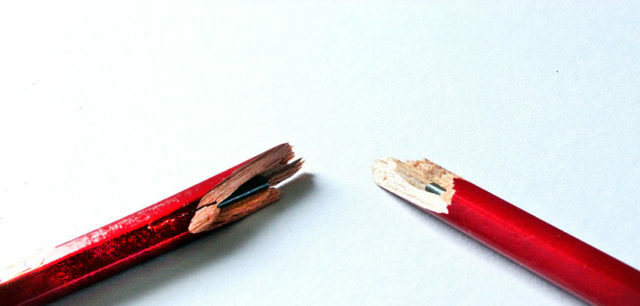
Contents of the page
- 1 Compression fracture of the spine - injury mechanism
- 2 Causes of
- 3 Classification and degrees
- 4 Symptoms of
- 5 Treatment of
- 6 What are the operations and when they are prescribed
- 7 Treatment in children
- 8 LFK
Fracture is a violation of the integrity of the bone structure. Compression fracture of the spine is a trauma accompanied by compression of the vertebral body as a result of external forces of flexion and compression. Bone structures crack and, as it were, "squeeze", mainly in the anterior parts, the vertebra at the same time acquires a wedge shape.
Compression fracture of the spine - the mechanism of injury
At the time of injury, a defensive reaction of the body occurs - the muscles of the press and flexors of the chest contract. At the same time, the upper limb belt tilts forward. A high pressure is formed, the point of application of which are the anterior parts of the vertebral bodies.
The main feature of the compression fracture is the stability of neurological and mechanical damage( with mild severity).Compression is susceptible to the lower thoracic and upper lumbar spine.
Reasons for 
- The most common cause of fracture with compression is trauma, the main features of which are a high, sharp load on the vertical axis and inclination of the spine anteriorly. Such a mechanism is usually realized when jumping or falling from a height with a landing on its feet;at the time of the car accident.
- Among the underlying causes of fracture without significant physical impact from the outside is the "weakness" of bone structures, for example, with osteoporotic changes. Osteoporosis causes a disturbance of metabolic processes in the bone, significantly increasing its fragility and fragility. Decreasing the strength of the bone structure leads to the impossibility of adequately resisting high loads. As a result, vertebral fracture can occur with a banal torso tilt forward.
-
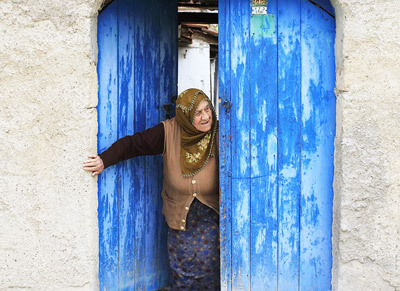 Therefore, almost forty percent of women by the age of 80 years have a fracture of at least one vertebra. The cause is pronounced osteoporotic bone changes due to the redistribution of the hormonal background in the climacteric and postmenopausal periods.
Therefore, almost forty percent of women by the age of 80 years have a fracture of at least one vertebra. The cause is pronounced osteoporotic bone changes due to the redistribution of the hormonal background in the climacteric and postmenopausal periods. - Metastases. Metastatic spinal involvement leads to destruction of the bone structure and increased risk of the effects of compression.
- Any other diseases, accompanied by an increase in the fragility of the skeleton - dysplasia, metabolic disorders, autoimmune pathologies.
- Compression fracture of the spine in children is formed when falling on the back from a slight height or on a horizontal level surface.
Classification and degrees
By location:
- fracture of cervical vertebrae;
- compression fracture of the thoracic spine ;
- compression department of lumbar spine ;
- single fractures of the vertebrae of the sacrum are almost impossible - trauma of this department is often accompanied by damage to several vertebrae;
- the aforesaid can also be used in relation to the coccygeal department.
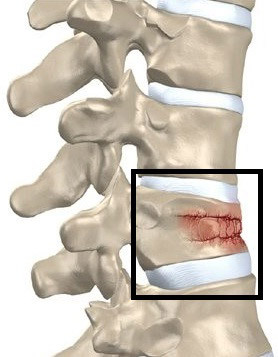 By volume of damage:
By volume of damage:
- isolated: fracture of one vertebral body;
- multiple: suffers two or more vertebrae( they may be located nearby or in different departments);
- with or without spinal cord injury.
Classification to reduce the height of the vertebral body( in terms of severity):
- I - less than one third;
- II - less than one second;
- III - decrease in body height by more than 50%.
Also distinguish:
- non-penetrating fractures. In this case, compression is not accompanied by damage to the intervertebral discs. The integrity of the end plates is preserved( bordering the vertebral body on the side of the discs of the cartilaginous surfaces).
In such conditions, the recovery process takes place much more quickly due to the fixing of the body of the vertebrae to the zones. Penetrating fractures.
-  .The compression of the vertebral body is accompanied by a fracture of one or both cartilaginous plates and damage to the disc( usually overlying).Trauma is accompanied by displacement of the vertebra, which is secondary in nature, increased deformation in its anterior regions and in the future - an increase in the forming kyphosis( hump).Surgery may be required for the type of partial removal of the damaged vertebral body with subsequent fixation of the injured area.
.The compression of the vertebral body is accompanied by a fracture of one or both cartilaginous plates and damage to the disc( usually overlying).Trauma is accompanied by displacement of the vertebra, which is secondary in nature, increased deformation in its anterior regions and in the future - an increase in the forming kyphosis( hump).Surgery may be required for the type of partial removal of the damaged vertebral body with subsequent fixation of the injured area.
Classification according to F. Denis( used in the clinic):
- A - c injury of both cartilaginous plates;
- B - with injury of the overlying closure plate;
- C - c injury of the underlying plate;
- D - fracture, covering exclusively the front sections.
Symptoms
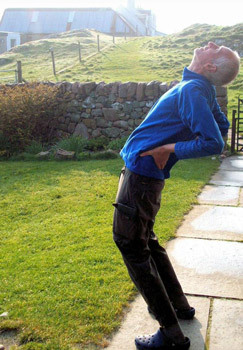 The main symptom of a compression fracture is acute, intense pain at the time of injury. If the thoracic, cervical parts are injured, breathing difficulties may occur.
The main symptom of a compression fracture is acute, intense pain at the time of injury. If the thoracic, cervical parts are injured, breathing difficulties may occur.
After a while, there is pain in the back, at the location of the lesion. Sometimes the sensations can radiate into the stomach or another zone.
The pain syndrome decreases in the horizontal position, increases when you try to move or stand. The tension of the back muscles is noted, especially in the damaged area, difficulty in turning, tilting.
The patient may present additional complaints of vomiting, nausea, dizziness, severe headache. Depending on the site of damage, motor, sensory disorders( for example, numbness of the upper and lower extremities) are possible.
If the fracture is provoked not by trauma, but by the fragility of the osseous structure( osteoporosis), the pain syndrome is gradually increasing. Initially, the patient does not pay any attention to it - the specialist is already treated with the development of serious neurological disorders.
First Aid Assistance
If you suspect a compression fracture, call an ambulance immediately.
Your actions before the arrival of medical personnel:
-
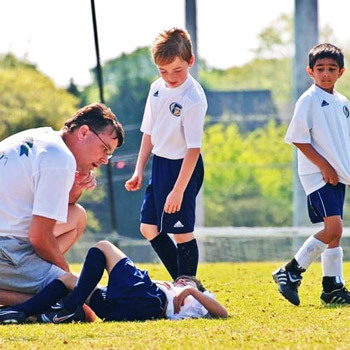 patient to lay on a hard and flat surface( you can use any improvised means, for example, boards);
patient to lay on a hard and flat surface( you can use any improvised means, for example, boards); - if nothing is suitable, you can use a soft stretcher, but in this case, the patient is placed on the stomach( under the chest put a cushion, pillow);
- suspicion of compression fracture of the cervical vertebra - try to fix the cervical section as much as possible;
- suspicion of a fracture of the thoracic or lumbar vertebra - place a roller under the damaged area.
Diagnosis
Compression fracture of the spine is a diagnosis of three specialists: a radiologist, traumatologist and neurologist.
The beginning of any diagnosis is the collection of anamnesis and examination of the patient. The doctor determines the cause, so it is necessary to report as much as possible about the injuries that have occurred recently, which may act as a possible cause of the fracture.
With external examination, local soreness is determined at the site of injury, the neurologist is determined with the presence of neurologic symptoms. A careful study at this stage allows you to suspect a possible level of fracture with an accuracy of several vertebrae.
Instrumental examination methods: 
- X-ray of the damaged department( usually in two projections) allows localizing the lesion;
- for more detailed study of the injured vertebra may be the appointment of a computer tomography;
- CT-myelography is necessary to assess the presence and extent of damage to the cerebrospinal structures;
- MRI - not only maximizes the degree of damage, the condition of cartilage plates of the vertebra, but also the degree of trauma to the nerve structures surrounding the soft tissues;
- densitometry is performed in women over 50 with a compression fracture for detailed diagnosis of osteoporosis.
Treatment
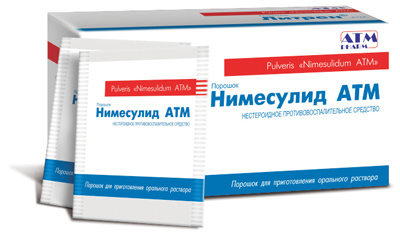 Treatment activities consist of three items:
Treatment activities consist of three items:
- pain relief;
- fixation of the damaged department;
- restriction of physical activity.
To eliminate pain, anti-inflammatory non-steroid agents( aceclofenac, nimesulide, ketoprofen) are recommended. From drugs at the stage of recovery, drugs are added that allow accelerating tissue repair( chondroitins, calcium preparations and so on).
Activity is minimized: no serious strain on the spine, lifting weights, prolonged standing and sitting. In the horizontal position - only a hard, flat surface. For people over 50( especially female) - recommended a long bed rest due to the presence of osteoporotic changes and prolonged regenerative processes in time.
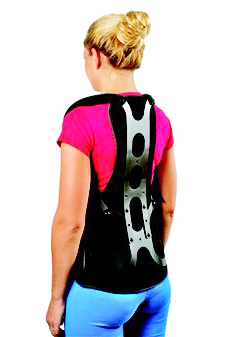 Fixation is performed with orthopedic corsets. The corset with compression fracture of the spine allows to partially relieve the affected department and facilitates the realization of favorable conditions for reconstructing the vertebral structure.
Fixation is performed with orthopedic corsets. The corset with compression fracture of the spine allows to partially relieve the affected department and facilitates the realization of favorable conditions for reconstructing the vertebral structure.
The average time for complete healing is about 3-4 months. X-ray control is carried out monthly.
Physiotherapy is prescribed after 1.5-2 months from the beginning of treatment. Recovery after a compression fracture of the spine occurs six months later.
What are the operations and when they are prescribed by
? Procedures accompanied by minimal invasion in case of vertebral fracture are kyphoplasty and vertebroplasty. They are used in the absence of damage to nerve structures.
Vertebroplasty: the introduction of a special cementing substance into the body of the damaged vertebra, which allows to strengthen the bone structure and prevent further complications( it is especially important in case of injury to the cartilaginous plate).
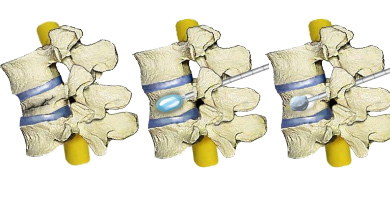 Kyphoplasty: helps partially restore the height of the vertebral body. Through a puncture, special chambers are introduced into the vertebra, which are then inflated and fixed with a special substance.
Kyphoplasty: helps partially restore the height of the vertebral body. Through a puncture, special chambers are introduced into the vertebra, which are then inflated and fixed with a special substance.
Serious surgical operation is indicated for instability of the spine( rarely) or neurological manifestations that indicate a spinal cord injury. This is usually a resection( partial removal) of bone structures followed by fixation with implants.
Any surgical intervention carries risks. For this case it is:
- neurological complications;
- kyphotic deformation;
- segmental instability( leads to acceleration of degenerative changes in the spine).
Treatment in children
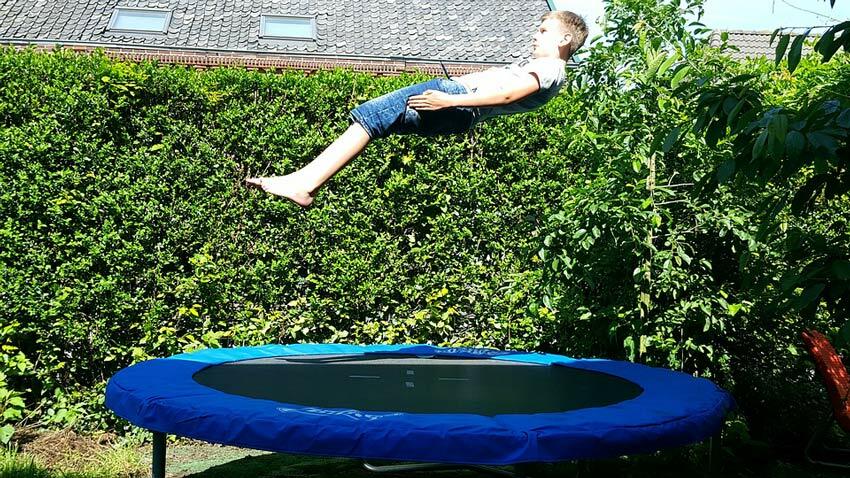 Compression fracture of the spine in children has its own characteristics. The most frequent localization is the midship department. In second place - lumbar, then upper and lower thoracic. The cervical department closes the list( 2% of all cases).Typically, several adjacent vertebrae are injured at a time, sometimes 1-2 whole are present between two broken vertebrae.
Compression fracture of the spine in children has its own characteristics. The most frequent localization is the midship department. In second place - lumbar, then upper and lower thoracic. The cervical department closes the list( 2% of all cases).Typically, several adjacent vertebrae are injured at a time, sometimes 1-2 whole are present between two broken vertebrae.
Three quarters of patients among children's category have a lesion of 3-5 vertebrae. Unfortunately, the diagnosis is difficult, and most children( 65%) do not undergo proper examination on the day of the injury.
For children's fractures, the damage of both cartilaginous plates is pathognomonic( in adults this variant of fracture is practically not found).
In this regard, the treatment of compression fracture in children has its own characteristics.
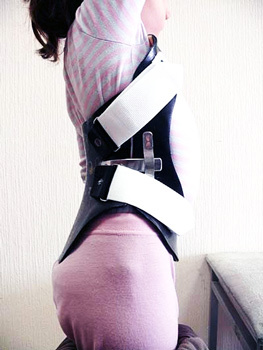 Among the conservative techniques used:
Among the conservative techniques used:
- one-stage reposition( restoration of the previous position of bone structures) followed by the use of a corset from gypsum;
- gradual repositioning;
- functional methodology.
The latter is currently used most often. Its essence is in the unloading extension of the spine. Thanks to the functional technique it became possible to prevent further deformation of the damaged area. The therapeutic gymnastics used in addition to it strengthens muscles and promotes the formation of a muscular corset.
Regarding the first two methods, prolonged wearing of corsets has its drawbacks:
- unhygienic( it is not possible to replace the product with a new one before the end of the wearing period);
- fixation together with the damaged area of holistic bone structures - the result is a restriction of movement, muscle wasting, the risk of osteoporotic changes, the need for subsequent long-term rehabilitation.
Functional methodology
This method is divided into two stages: stationary, requiring hospitalization of the patient, and outpatient. The first stage includes( in addition to stretching) physiotherapy, massage, exercise therapy.
It is recommended to conduct early activation of patients due to the negative impact of bed rest on the structure of bone tissue. With continued immobilization for a month, the risk of developing secondary osteoporosis is significantly increased. Therefore, after carrying out the necessary procedures, a small patient is transferred to wearing a corset, while the intensity of therapeutic gymnastics increases.
As for the outpatient stage - it includes wearing a corset, physiotherapy. A special place is occupied by exercise therapy after a compression fracture of the spine for the corresponding period. The optimal load regimen, proper nutrition, allows to significantly shorten the terms of rehabilitation.
Rehabilitation activities
 Rehabilitation after compression fracture of the spine is mandatory. It is necessary to restore the functional properties of the spine - flexibility and mobility, as well as at least partial elimination of kyphotic curvature.
Rehabilitation after compression fracture of the spine is mandatory. It is necessary to restore the functional properties of the spine - flexibility and mobility, as well as at least partial elimination of kyphotic curvature.
General principles:
- Once every six months( up to two years of recovery), physiotherapy is necessary. Usually use electrophoresis, paraffin. Rarely: radiotherapy. It is useful to combine physiotherapy with massage.
- It is forbidden to sit( to avoid unnecessary strain on the spine) - an average of 4 to 6 months after the injury. The duration of this period is determined by the attending physician. It is allowed to kneel( using a soft lining).
- For sleeping - only orthopedic mattresses. On the appointment of a doctor under the neck, you can put a hard roller.
- Often after treatment, experts recommend continuing wearing a corset, replacing the hard product with a lighter version.
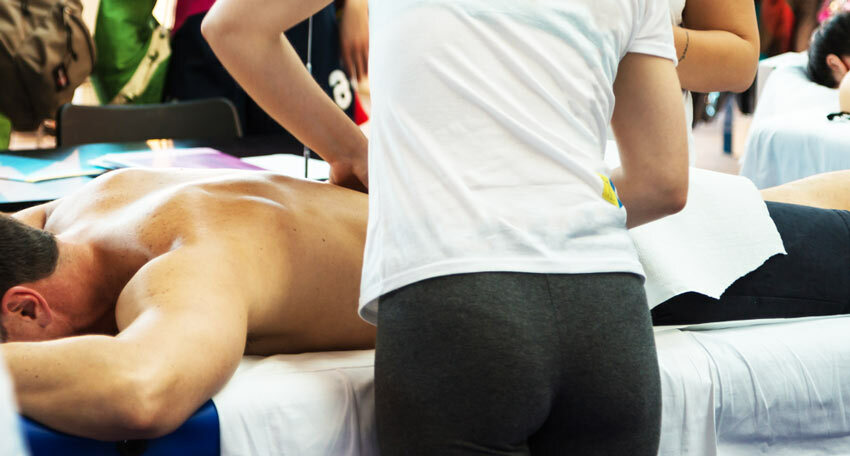 Massage is performed at different stages of recovery and is necessary to improve blood circulation and metabolic processes in the affected area. In addition, the passivation of the hands of the masseur stimulates the nerve centers and reduces the reflex excitability.
Massage is performed at different stages of recovery and is necessary to improve blood circulation and metabolic processes in the affected area. In addition, the passivation of the hands of the masseur stimulates the nerve centers and reduces the reflex excitability.
Types such as reflex, classical and acupressure are applied.
Procedure is executed smoothly, without jerks. The duration of the session is 15 minutes twice a day. The technique becomes more complicated as the treatment progresses - in the second period, the main goal is to restore the functionality of the spinal column. Therefore, calm, soft movements are replaced by grinding, squeezing, kneading.
LFK
Exercises after a compression fracture of the spine are appointed after an acute period. The whole process should be under strict supervision of a specialist, the movements should exclude jerks, have a small amplitude, be extremely cautious, otherwise the disease may become aggravated.
LFK after a compression fracture of the spine consists of respiratory gymnastics, combined with elementary exercises. As the restoration progressively expands the kneaded area: exercises are added to all kinds of muscle groups. Inactivity of the muscles not only leads to their hypotrophy, but also partially turns off the work microcirculation, which supports the inflammatory process and contributes to the chronic pain.
- The first stage( 2 weeks, 15 minutes per day) - breathing exercises, combined with the maximum amount of movements of the hands, flexion of the spine with the use of the limbs.
- The second stage( a month, for 25 minutes daily) - turns on the stomach, tilts and turns of the trunk, possibly lifting the legs.
- The third stage( 3 weeks, up to 45 minutes) - add exercises in a pose kneeling.
- Fourth stage - after gradual adaptation of moderate walking, leg muscles training.
LFK continues the entire rehabilitation period, even after discharge from the hospital.
